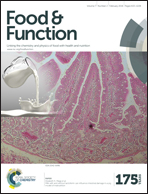In silico, in vitro and in vivo analyses of dipeptidyl peptidase IV inhibitory activity and the antidiabetic effect of sodium caseinate hydrolysate
Abstract
The frequency (A), a novel in silico parameter, was developed by calculating the ratio of the number of truncated peptides with Xaa-proline and Xaa-alanine to all peptide fragments from a protein hydrolyzed with a specific protease. The highest in vitro DPP-IV inhibitory activity (72.7%) was observed in the hydrolysate of sodium caseinate by bromelain (Cas/BRO), and the constituent proteins of bovine casein also had relatively high A values (0.10–0.17) with BRO hydrolysis. 1CBR (the <1 kDa fraction of Cas/BRO) showed the greatest in vitro DPP-IV inhibitory activity of 77.5% and was used for in vivo test by high-fat diet-fed and low-dose streptozotocin-induced diabetic rats. The daily administration of 1CBR for 6 weeks was effective to improve glycaemic control in diabetic rats. The results indicate that the novel in silico method has the potential as a screening tool to predict dietary proteins to generate DPP-IV inhibitory and antidiabetic peptides.


 Please wait while we load your content...
Please wait while we load your content...